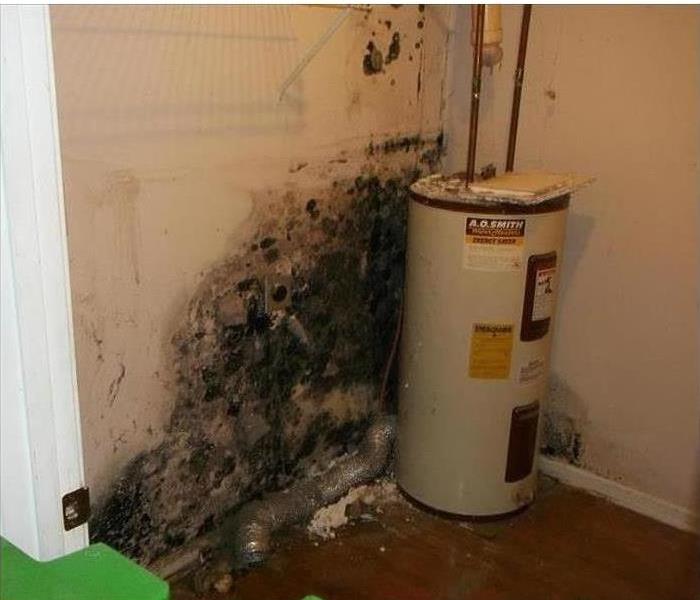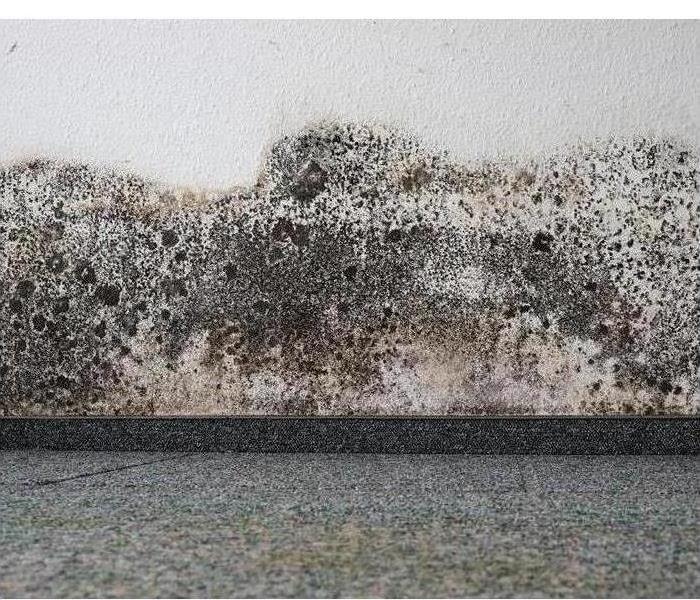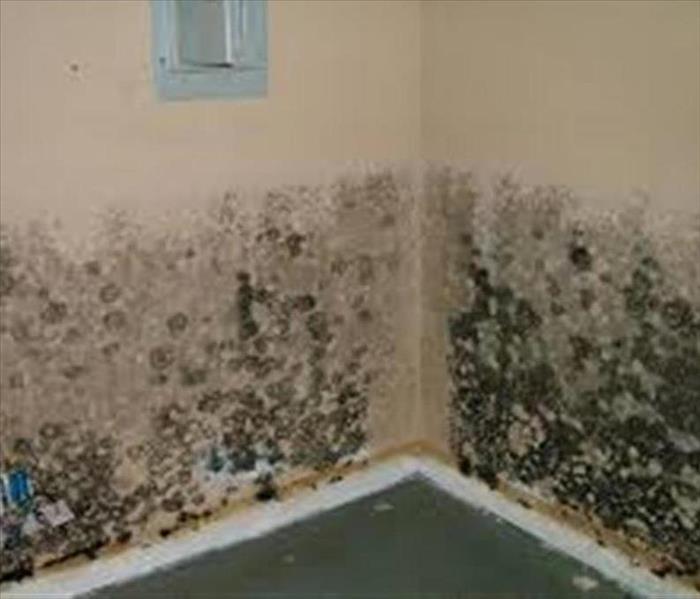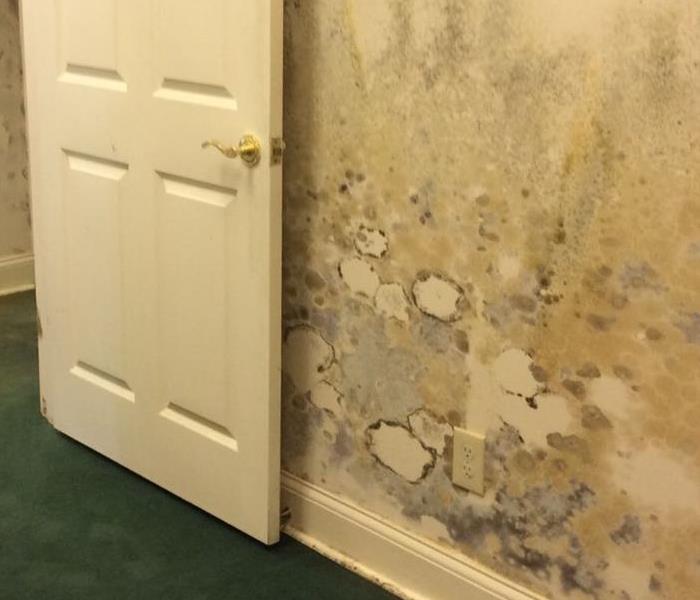Recent Mold Remediation Posts
Do you have Mold?
10/8/2019 (Permalink)
Microscopic mold spores naturally occur almost everywhere, both outdoors and indoors. This makes it impossible to remove all mold from a home or business. Therefore, mold remediation reduces the mold spore count back to its natural or baseline level. Some restoration businesses advertise “mold removal” and even guarantee to remove all mold, which is a fallacy. Consider the following mold facts:
- Mold is present almost everywhere, indoors and outdoors.
- Mold spores are microscopic and float along in the air and may enter your home through windows, doors, or AC/heating systems or even hitch a ride indoors on your clothing or a pet.
- Mold spores thrive on moisture. Mold spores can quickly grow into colonies when exposed to water. These colonies may produce allergens and irritants.
- Before mold remediation can begin, any sources of water or moisture must be addressed. Otherwise, the mold may return.
- Mold often produces a strong, musty odor and can lead you to possible mold problem areas.
Even higher-than-normal indoor humidity can support mold growth. Keep indoor humidity below 45 percent.
If your home or business has a mold problem, we can inspect and assess your property and use our specialized training, equipment, and expertise to remediate your mold infestation
Dealing with Mold
10/8/2019 (Permalink)
When there is water in your home, mold can quickly become an issue. It can cause health issues and damage to your property. SERVPRO of Northeast Delta Lands has the training, protective gear, and specialized equipment to handle your mold problem.
Call SERVPRO of Northeast Delta Lands
The mold cleanup and restoration process begins when you call us. One of our employees will ask a series of questions to help determine the necessary equipment, resources, and personnel needed.
Assessment
Your property will be carefully inspected for signs of mold using various technologies to detect mold and hidden water sources. Mold feeds on cellulose and water and can be hidden from plain view.
Containment
Different containment procedures will be placed to prevent the spread of mold, like negative air chambers to isolate the contaminated area with physical barriers and negative air pressure to keep the mold spores from spreading during the cleanup process.
Air Filtration
Specialized filtration equipment captures microscopic mold spores out of the air. SERVPRO of Northeast Delta Lands technicians use powerful air scrubbers and HEPA vacuums to prevent the spread of these mold spores while the mold remediation is in progress.
Removing
The process of mold remediation depends on the amount of mold growth and the type of surface it's on. Anti-fungal and antimicrobial treatments will be used to eliminate mold colonies and help prevent new ones from forming. Removing and disposing of mold-infested porous materials, like drywall and flooring, may be necessary.
Cleaning
SERVPRO of Northeast Delta Lands cleans your furniture, decorative items, curtains, and other restorable items affected by mold. We use a variety of cleaning techniques to clean and sanitize your belongings.
Restoration
Depending on the level of mold damage, some building materials may have to be removed. Restoration may involve minor repairs or major repairs such as reconstruction.
WHAT IS MOLD AND WHY DOES IT SMELL MUSTY?
8/27/2018 (Permalink)

You may not learn about the mold problem in your building until you hear complaints about the irritating musty odor. Some people think that the smell actually comes from tiny particles of mold in the air or from mold spores. Neither are true. Odors from molds are caused by mycotoxins, which are gases released during the digestive process of some molds.
What Is Mold?
Molds are fungi, just like mushrooms. Some scientists think the mycotoxin production from certain types of molds is actually an adaptation developed to protect the molds from animals and insects. Nobody is sure how many varieties of mold live on our planet because they are so abundant, living wherever oxygen and moisture are found, especially here in the humid South. Since molds exist abundantly in our environment, it's just about impossible to keep them out. Here are a few ways the spores can enter a building:
• On pets and clothing
• Through windows and doors
• Via cooling, ventilation, and heating systems
The problem is when mold spores land in a hospitable environment, one with organic material, moisture, and oxygen. That is when the mold begins to grow and form colonies. As it grows, it consumes organic material as food, producing that familiar musty smell.
How Can You Prevent Mold?
The best way to prevent molds is to make sure you are not providing a welcome environment for their growth and development. You can manage your building's environment by reducing humidity with ventilation systems and dehumidifiers, fixing leaky areas from pipes or roofing, and proper remediation of water damage.
When you do follow that musty odor to the source and discover mold in your building, at least you can count on professional mold remediation specialists here at SERVPRO of Northeast Delta Lands to clean up the problem. During the cleaning process, professionals use HEPA air filtration equipment and containment procedures to reduce further spread of mold spores inside your building. This cleanup process will prevent mycotoxin production, making the environment more hospitable to your human building occupants again.
Got Mold?
8/23/2018 (Permalink)
Homeowners that detect mold in their dwellings can seek help from a qualified remediation professional. It can be confusing as to which removal method is best for their homes. Let SERVPRO of Northeast Delta Lands worry about that. Remediation efforts differ when it comes to the affected surfaces. Mold found on porous materials, such as dry wall, carpet and insulation, must be remediated through the complete removal of these materials. These porous materials must be properly disposed of in order to ensure complete mold spore removal. However, nonporous or semi porous materials, such as concrete or hardwoods, can remain in the home to be properly sanitized depending on their level of damage. The professionals at SERVPRO of Northeast Delta Lands are trained to handle mold remediation and are always willing to check the mold situation before remediation begins.
Mold Safety Tips
5/22/2018 (Permalink)
If you see visible mold, do not disturb it. You can inadvertently spread the mold infestation throughout your home. When mold is disturbed, the mold can release microscopic mold spores which become airborne and can circulate inside your home.
What to Do:
- Stay out of affected areas.
- Turn off the HVAC system and fans.
- Contact SERVPRO of Northeast Delta Lands for mold remediation services.
What Not to Do:
- Don’t touch or disturb the mold.
- Don’t blow air across any surfaces with visible or suspected mold growth.
- Don’t attempt to dry the area yourself.
- Don’t spray bleach or other disinfectants on the mold.
About Our Mold Remediation Services
SERVPRO specializes in mold cleanup and restoration, in fact, it’s a cornerstone of our business. Our crews are highly trained restoration professionals that use specialized equipment and techniques to properly remediate your mold problem quickly and safely.
Damage from Mold Colonies is Minimized by SERVPRO Remedy
5/18/2018 (Permalink)
Mold damage can be notoriously difficult to remedy. Trying to clean the damage by yourself can worsen the situation and can even cause the mod to spread to unaffected areas. Restoration experts have the necessary safety and cleaning equipment to get the job done safely and efficiently. Understanding the basics of mold damage to your home can help you prepare better if you spot some early signed of the damage.
Unfortunately mold spores are everywhere and eliminating them entirely isn't possible. However, it is possible to prevent conditions that promote their germination and growth. One of the most important factors promoting growth is moisture. Eliminating moisture from your house is your best defense.
The mold damage restoration process is a job for the experts and should not be treated as a DIY project. SERVPRO technicians can help you remediate the problem safely and efficiently.
UNOCCUPIED HOMES
4/16/2018 (Permalink)
The month of January brought in two weather fronts that brought us some of the coldest weather for longer than we had seen in while. The first one was early in the month, just after the first of the year and the second came close to the middle of the month. We all try to prepare for the below freezing temps but the timing in which these came caught a lot of people were still out of town. A lot of the homes we worked in that were severely affected were unoccupied over the holidays. Water ran from frozen lines in some homes for up to 5 days in some cases, maybe more some homes the owners were unsure exactly when the burst occurred. As a home owner, if you know these weather conditions are coming and you have already left town, always have a plan, leave a key for someone so they can periodically check in or even hire a house sitter. This one simple move could save you thousands.
You Can Control Mold
2/21/2018 (Permalink)
Inside your home you can control mold growth by:
- Controlling humidity levels;
- Promptly fixing leaky roofs, windows, and pipes;
- Thoroughly cleaning and drying after flooding;
- Ventilating shower, laundry, and cooking areas.
If mold is growing in your home, you need to clean up the mold and fix the moisture problem. Mold growth can be removed from hard surfaces with commercial products, soap and water, or a bleach solution of no more than 1 cup of household laundry bleach in 1 gallon of water.
Mold growth, which often looks like spots, can be many different colors, and can smell musty. If you can see or smell mold, a health risk may be present. You do not need to know the type of mold growing in your home, and CDC does not recommend or perform routine sampling for molds. No matter what type of mold is present, you should remove it. Since the effect of mold on people can vary greatly, either because of the amount or type of mold, you can not rely on sampling and culturing to know your health risk. Also, good sampling for mold can be expensive, and standards for judging what is and what is not an acceptable quantity of mold have not been set. The best practice is to remove the mold and work to prevent future growth.
If you choose to use bleach to clean up mold:
- Never mix bleach with ammonia or other household cleaners. Mixing bleach with ammonia or other cleaning products will produce dangerous, toxic fumes.
- Open windows and doors to provide fresh air.
- Wear non-porous gloves and protective eye wear.
- If the area to be cleaned is more than 10 square feet, consult the U.S. Environmental Protection Agency (EPA) guide titled Mold Remediation in Schools and Commercial Buildings. Although focused on schools and commercial buildings, this document also applies to other building types.
- Always follow the manufacturer’s instructions when using bleach or any other cleaning product.
www.cdc.gov




 24/7 Emergency Service
24/7 Emergency Service




